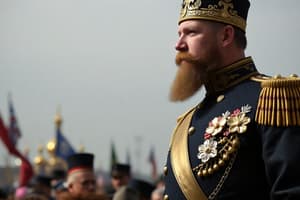Podcast
Questions and Answers
Who was Nicholas II forced to abdicate in favor of?
Who was Nicholas II forced to abdicate in favor of?
- The head of the Petrograd Soviet
- The city commandant
- Prince Lvov
- His brother Michael (correct)
Who was responsible for the prisoners' execution in the early hours of July 17?
Who was responsible for the prisoners' execution in the early hours of July 17?
- The Petrograd Soviet
- The local authorities (correct)
- Anti-Bolshevik 'White' Russian forces
- Prince Lvov's provisional government
Where were the prisoners taken before their execution?
Where were the prisoners taken before their execution?
- Tsarskoye Selo
- Petrograd
- Yekaterinburg (correct)
- Tobolsk
Why was Nicholas II detained at Tsarskoye Selo?
Why was Nicholas II detained at Tsarskoye Selo?
What was the fate of the executed prisoners' bodies?
What was the fate of the executed prisoners' bodies?
What prompted Nicholas II to instruct the city commandant to send troops to restore order in Petrograd?
What prompted Nicholas II to instruct the city commandant to send troops to restore order in Petrograd?
Study Notes
Russian Conflict and the Execution of the Tsar
Abdication and Death of Nicholas II
In March 1917, riots broke out in Petrograd (formerly St. Petersburg), prompting Nicholas II to instruct the city commandant to take firm measures and send troops to restore order. However, the situation had already escalated, and on March 15, the government resigned, and the Duma, supported by the army, called on the emperor to abdicate. Nicholas chose to abdicate in favor of his brother Michael, but Michael refused the crown.
Nicholas was then detained at Tsarskoye Selo by Prince Lvov's provisional government, with plans to send him and his family to England. However, due to opposition from the Petrograd Soviet, the revolutionary Workers' and Soldiers' Council, the family was moved to Tobolsk in Western Siberia, which ultimately sealed their fate.
Execution of the Tsar and His Family
In July 1918, the prisoners were taken to Yekaterinburg in the Urals, and when anti-Bolshevik "White" Russian forces approached the area, the local authorities were instructed to prevent a rescue. In the early hours of July 17, the prisoners, including Nicholas II, his family, and four servants, were executed in the cellar of the house where they had been confined. The bodies were then burned, cast into an abandoned mine shaft, and hastily buried elsewhere. The remains of Nicholas, Alexandra, three of their daughters (Anastasia, Tatiana, and Olga), and four servants were identified in 1976, and a state funeral was held on July 17, 1998, in the crypt of the Cathedral of St. Peter and St. Paul in St. Petersburg. The remains of Alexis and another daughter (Maria) were identified in 2007, with DNA testing confirming their identity.
Canonization and Rehabilitation
The Russian Orthodox Church canonized Nicholas II and his family on August 20, 2000, designating them "passion bearers," the lowest rank of sainthood. On October 1, 2008, Russia's Supreme Court ruled that the executions were acts of "unfounded repression," granting the family full rehabilitation.
Studying That Suits You
Use AI to generate personalized quizzes and flashcards to suit your learning preferences.
Description
Explore the events surrounding the abdication and eventual execution of Tsar Nicholas II and his family during the Russian Revolution. Learn about the circumstances leading to their detention, transfer, and tragic demise in 1918, as well as their canonization and rehabilitation in later years.




